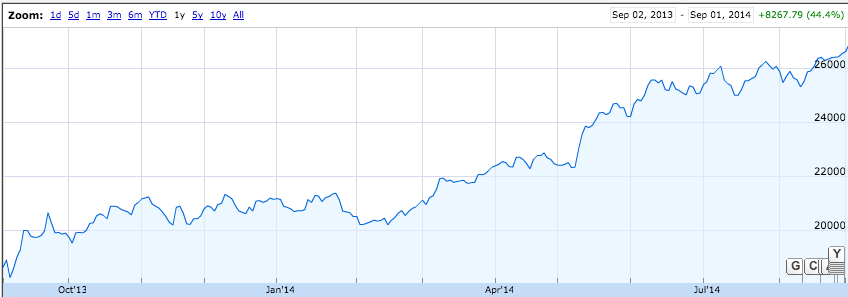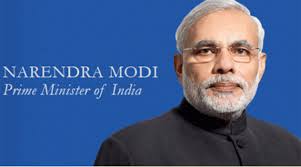
For emerging markets watchers, the revival of the Indian economy in recent months has been reassuring under Prime Minister Narendra Modi and has driven the Sensex India index to record highs. The index is up 27% year to date after the latest data showed that India’s GDP grew at its fastest pace in more than two years after confidence has been boosted by new government and Reserve bank policies to stimulate the economy.
Gross domestic product rose 5.7% in the three months ended June from a year earlier and head of expectations, the biggest gain since the quarter through March 2012 and compared with the 4.6%. Output from the manufacturing sector rose 3.5% last quarter, rebounding from a 1.2% contraction a year earlier. Output of electricity and some utilities grew 10.2%. Services such as community, social and personal services recorded 9.1% expansion while financing and insurance services rose 10.4%. Farm output also expanded 3.8%. Gross fixed capital formation, a gauge of asset creation and investment, rose 7% and government spending increased 8.8%
Prime Minister Narendra Modi’s government has tried to speed up reform and reduce red tape as well as increasing investment in infrastructure and industrial projects. In the first three months in office, Modi’s government has already made such changes as opening up India’s railways to foreign investment, increasing the opportunity for foreign ownership in defence companies and getting rid of the Planning Commission.

The Indian economy struggled in 2012 and 2013, with the economy growing just 4.7% in the year ended March 31, marking the first time in 25 years that GDP expansion has failed to reach 5% for two years in a row. A perception of an anti business regime has held back foreign investment with companies like Vodafone and Cairn Energy embroiled in retrospective tax rows with the authorities. Though the recent reforms have been welcome, there is much to do and many are calling on the government to be more aggressive in reforming to attract foreign investment and reduce the economy’s reliance on subsidies. Stronger economic growth is badly needed to reduce the budget deficit and fears of rising inflation.
Of the BRIC economies, India certainly looks best placed to continue its recovery assuming the Federal Reserve’s action in the US do not stop the flood of money coming into the emerging markets. There is still much for the Indian government to accomplish to make the lives of most of its citizens better, but it looks like there are some encouraging signs from this latest GDP data.
Contrarian Investor UK
IMPORTANT: The posts I make are in no way meant as investment suggestions or recommendations to any visitors to the site. They are simply my views, personal reflections and analysis on the markets. Anyone who wishes to spread bet or buy stocks should rely on their own due diligence and common sense before placing any spread trade.
by contrarianuk
Indian GDP growth points to economic recovery as reforms begin
Sep 1, 2014 at 11:13 am in Market Commentary by contrarianuk
For emerging markets watchers, the revival of the Indian economy in recent months has been reassuring under Prime Minister Narendra Modi and has driven the Sensex India index to record highs. The index is up 27% year to date after the latest data showed that India’s GDP grew at its fastest pace in more than two years after confidence has been boosted by new government and Reserve bank policies to stimulate the economy.
Gross domestic product rose 5.7% in the three months ended June from a year earlier and head of expectations, the biggest gain since the quarter through March 2012 and compared with the 4.6%. Output from the manufacturing sector rose 3.5% last quarter, rebounding from a 1.2% contraction a year earlier. Output of electricity and some utilities grew 10.2%. Services such as community, social and personal services recorded 9.1% expansion while financing and insurance services rose 10.4%. Farm output also expanded 3.8%. Gross fixed capital formation, a gauge of asset creation and investment, rose 7% and government spending increased 8.8%
Prime Minister Narendra Modi’s government has tried to speed up reform and reduce red tape as well as increasing investment in infrastructure and industrial projects. In the first three months in office, Modi’s government has already made such changes as opening up India’s railways to foreign investment, increasing the opportunity for foreign ownership in defence companies and getting rid of the Planning Commission.
The Indian economy struggled in 2012 and 2013, with the economy growing just 4.7% in the year ended March 31, marking the first time in 25 years that GDP expansion has failed to reach 5% for two years in a row. A perception of an anti business regime has held back foreign investment with companies like Vodafone and Cairn Energy embroiled in retrospective tax rows with the authorities. Though the recent reforms have been welcome, there is much to do and many are calling on the government to be more aggressive in reforming to attract foreign investment and reduce the economy’s reliance on subsidies. Stronger economic growth is badly needed to reduce the budget deficit and fears of rising inflation.
Of the BRIC economies, India certainly looks best placed to continue its recovery assuming the Federal Reserve’s action in the US do not stop the flood of money coming into the emerging markets. There is still much for the Indian government to accomplish to make the lives of most of its citizens better, but it looks like there are some encouraging signs from this latest GDP data.
Contrarian Investor UK
IMPORTANT: The posts I make are in no way meant as investment suggestions or recommendations to any visitors to the site. They are simply my views, personal reflections and analysis on the markets. Anyone who wishes to spread bet or buy stocks should rely on their own due diligence and common sense before placing any spread trade.